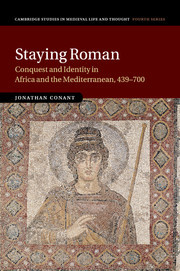Description
Staying Roman
Conquest and Identity in Africa and the Mediterranean, 439–700
Cambridge Studies in Medieval Life and Thought: Fourth Series
Author: Conant Jonathan
This is the first systematic study of the changing nature of Roman identity in post-Roman North Africa.
Language: English
Subject for Staying Roman:
Approximative price 36.76 €
In Print (Delivery period: 14 days).
Add to cart
Staying Roman
Publication date: 10-2015
Support: Print on demand
Publication date: 10-2015
Support: Print on demand
Approximative price 93.25 €
In Print (Delivery period: 14 days).
Add to cart
Staying roman: conquest and identity in africa and the mediterranean, 439â700
Publication date: 04-2012
442 p. · 15.8x23.4 cm · Hardback
Publication date: 04-2012
442 p. · 15.8x23.4 cm · Hardback
Description
/li>Contents
/li>Biography
/li>
What did it mean to be Roman once the Roman Empire had collapsed in the West? Staying Roman examines Roman identities in the region of modern Tunisia and Algeria between the fifth-century Vandal conquest and the seventh-century Islamic invasions. Using historical, archaeological and epigraphic evidence, this study argues that the fracturing of the empire's political unity also led to a fracturing of Roman identity along political, cultural and religious lines, as individuals who continued to feel 'Roman' but who were no longer living under imperial rule sought to redefine what it was that connected them to their fellow Romans elsewhere. The resulting definitions of Romanness could overlap, but were not always mutually reinforcing. Significantly, in late antiquity Romanness had a practical value, and could be used in remarkably flexible ways to foster a sense of similarity or difference over space, time and ethnicity, in a wide variety of circumstances.
Introduction; 1. The legitimation of Vandal power; 2. Flight and communications; 3. The old ruling class under the Vandals; 4. New Rome, new Romans; 5. The Moorish alternative; 6. The dilemma of dissent; Aftermath; Conclusions.
Jonathan Conant is Assistant Professor of History at the University of San Diego, where his teaching and research focus is on the ancient and medieval Mediterranean.
© 2024 LAVOISIER S.A.S.




